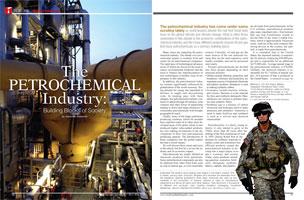
The petrochemical industry has come under some scrutiny lately as world leaders debate the role that fossil fuels have on the global climate and climate change. What is often times overlooked in this debate is the economic contributions of the petrochemical industry and the many different products beyond oil and gas that have petrochemicals as a primary building block.
Many issues are impacting the petrochemical industry. The debate over environmental impact is certainly front and center for all petrochemical companies. The rapid pace of technological advances (most of which are driven by the need to reduce environmental footprint) and the need to finance the implementation of new technologies is another issue of importance to this industry.
In addition, the petrochemical industry remains significantly influenced by globalization of the world economy. Rising demand for energy has translated to declines in supply and skyrocketing costs. In keeping pace with these changes, the petrochemical industry continues to adjust through divestitures, joint ventures and other forms of partnership leading to fewer and larger producers of commodity petrochemicals with broader geographical reach.
Finally, many of the larger petroleum producing countries, which for decades have exported crude oil to other more developed areas of the globe which in turn produced higher value-added products, are now making investments in the development of their own petrochemical producing capacity. The introduction of these companies into the global market has had a mixed impact.
We will discuss these issues and more in this article, but first let’s review the industry and its economic impact.
Petrochemicals are simply defined as chemicals produced from petroleum. Some petrochemical compounds can also be obtained from other fossil fuels such as coal or natural gas, or even renewable sources. Currently, oil and gas are the main sources of the raw materials because they are the least expensive, most readily available, and can be processed most easily.
Primary petrochemicals are divided into three groups depending on their chemical structure:
Olefins include ethylene, propylene, and butadiene. Ethylene and propylene are important sources of industrial chemicals and plastics products. Butadiene is used in making synthetic rubber.
Aromatics include benzene, toluene, and xylenes. Benzene is a raw material for dyes and synthetic detergents. Manufacturers use xylenes to produce plastics and synthetic fibers.
Synthesis gas is a mixture of carbon monoxide and hydrogen used to make ammonia and methanol. Ammonia is used to make fertilizer and methanol is used as a solvent and chemical intermediate.
Petrochemistry is a fairly young industry; it only started to grow in the 1940s, more than 80 years after the drilling of the first commercial oil well in 1859. During World War II, the demand for synthetic materials to replace costly and sometimes less efficient products caused the petrochemical industry to develop into a major player in today's economy and society. Today, many products, including gasoline, cosmetics, fertilizers, detergents, synthetic fabrics, asphalt, and plastics are all made from petrochemicals. In the U.S. military, petrochemical products play many important roles – from helmets that can stop 9-millimeter rounds to Kevlar fiber to the Army Combat Uniform worn by every soldier in the United States Army, which is approximately 50 percent nylon. And one of the most common life-saving devices in the country, the seatbelt, is made from petrochemicals.
It is estimated that in the United States, the chemical industry is responsible for directly employing 850,000 people and is responsible for an additional 4,675,000 jobs. Average annual wage in the petrochemical industry is $78,000. Globally, the chemical industry is responsible for $3.7 trillion of annual output, 18.6 percent of that is produced in the United States.
Trends
As mentioned above there are many trends impacting the petrochemical industry. The need to reduce overall environmental impact as well as the desire to increase productivity has lead to the rapid deployment of technological advancements in the industry. The need to continue that technological deployment is driving capital investments.
Technology and Environmental Impact
The world continues to focus on the impact that fossil fuel consumption has on environmental conditions. As a response to that, most of the developed nations continue to regulate industries that are considered to be contributing the most to the negative environmental conditions including the petrochemical industry. This has driven the industry to invest very heavily in pollution control equipment.
Some states and communities look for ways to incent and reward companies who make investments in pollution reduction by allowing certain classes of pollution control equipment to be exempt from property taxes. This practice should continue in order to help those companies make the significant investments necessary to maintain a limited impact on the environment. Additional incentives should be awarded to companies making significant capital investments and this is discussed below.
Technology and Safety
Producing these chemicals involves handling hazardous materials and managing large amounts of energy. In the drive to improve safety and reliability, chemical process facilities tend to rely heavily on automation using sophisticated instrumentation, computers, and programmable logic controllers to run their plants. In an effort to improve energy efficiency and reduce pollution, various pieces of equipment are interconnected in ways that complicate their operation. Chemical process accidents are often the result of unexpected interaction between automated process equipment and operators.
Again, investments into ever-improving technology can help reduce the number of accidents and incidents that occur. In order to improve the working conditions, the safety of employees and the community that surrounds the petrochemical plant, it is important that companies continue to make investments in improved process technology.
Globalization
The fastest-growing areas in petrochemical capacity are the Middle East and Asia outside of Japan, with double-digit annual growth rates. Most of the capacity buildup continues in these regions, furthering the globalization of the petrochemical industry. These areas are beginning to invest heavily in the facilities necessary to convert crude oil into the building block chemicals that make up the petrochemical industry.
This increased capacity will equate to increased competition in the petrochemical industry. This competition will be particularly acute for the petrochemical industry base in the developed nations. The reason for this is two-fold. These new investments are occurring in oil-rich countries and by companies who own much of the oil production and refining capacity. As a result they will be less vulnerable to supply shocks and price increases. Secondly, the safety and environmental regulations in those countries are less stringent than in the developed world which not only compromises the health and safety of the citizens of these countries but it also means that the petrochemical companies can operate with less capital investment.
Another result of globalization is the increased number of joint ventures and other partnerships which result in fewer players in the global market place.
Capital Investment and Incentives
There is one common theme from the trends discussed above and that is the increased capital investment made by petrochemical companies around the globe. That investment is critical to keeping the petrochemical industry productive, safe and clean. In the United States, as well as in most of the developed nations, these investments will naturally continue to occur at existing facilities rather than greenfield sites. Indeed, an analysis of the recent announcements in this industry shows that billions of dollars have been spent at existing plants around the globe. Much of this investment enables companies to increase the productivity of the physical plant that they have already constructed. This, in combination with the increased globalization of the industry, means that there will be fewer new facilities constructed in the developed nations and particularly in the United States.
One of the challenges for communities that depend on these facilities for both employment and tax revenue will be to encourage the continued investment in those facilities. Many times this new investment does not result in netting new jobs and many times the reverse is true – new capital investment results in a loss of jobs. Most of the traditional incentive programs in the United States focus on job creation not capital investment. For states and communities to be competitive in maintaining their existing base of petrochemical companies and to continue to grow those facilities, they are going to have to get creative in their incentive policies. In this day and age, it may not be politically expedient to incent companies that are not creating new jobs, but that capital investment is critically important to maintaining a significant tax base with extremely well-paying jobs.
Logistics
In addition to incentives another area in which public policy can influence or impact the success of a petrochemical facility is in the development and maintenance of logistics infrastructure. For most petrochemical facilities the most important infrastructure elements are port facilities and rail lines. For most petrochemical facilities, the logistics cost (for both inbound and outbound products) represents a significant variable portion of the annual operating budget. In addition, the reliability of the infrastructure is a critical concern. These companies need to be able to count on product quickly and easily reaching their facilities in order to keep their operations running.
Considerations for New Investments
As previously stated, there are not likely to be new greenfield investments in the industry. However, based on all of the other items reviewed in this article, there will certainly be new investments at existing facilities. Whether it is in new technology or new joint ventures to gain market share, petrochemical companies will have a choice in where they invest that capital.
Companies that have a choice in where they can invest and expand facilities should consider a few primary issues. First, which of the communities under consideration has a well-maintained and well-funded logistics network? This question will likely lead to the evaluation of ports, rail and road infrastructure. Locations that have not maintained port facilities or undertaken the expansions necessary to keep up with growth will likely be at a disadvantage. In addition, facilities that are fortunate enough to have access to dual rail-service offer an important competitive advantage. Finally, while less important than ports and rails, well-maintained road infrastructure should also be considered.
Secondly, are there significant differences in utility costs in the locations under consideration? Most petrochemical facilities are tremendous users of energy and to the extent that there are cost differentials between locations, communities with low cost power and fuel (natural gas, etc.) will be at an advantage.
Third, are there differences in the environmental regulations between the locations being considered? Some states and communities have imposed stricter environmental regulations than the federal government. As a result, it will take longer and be more costly to complete any significant expansions in those communities.
Finally, do the communities under consideration continue to support the investment of capital through the provision of property tax and other incentives? This will not be nearly as significant as the issues discussed above, but if everything else is equal this could be an important issue for evaluation. In looking at the incentives that may be available, a company should look first to a long-term property tax abatement. Secondly, a company should look for income tax credits or preferably rebates based on the amount of capital invested in the project. Finally, the state and community should offer sales tax exemptions for all machinery, equipment and construction materials purchased as part of the new project.

